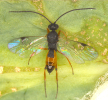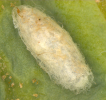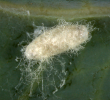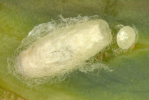 |
Scientific nameCotesia vestalis (Haliday) (=Apanteles plutellae Kurdjumov, Cotesia plutellae (Kurdjumov))
Shaw (2003) found that C. vestalis (Haliday) was a senior synonym of C. plutellae (Kurdjumov). Hence, C. vestalis is the valid name of the species, though C. plutellae is still widely used. Taxonomic positionHymenoptera: Ichneumonoidea: Braconidae: Microgastrinae
DiagnosisBody length less than 3 mm. Female antennae long, reaching apex of metasoma or nearly so. Entire mesosoma in lateral view not flattened dorsoventrally, less than 1.5x as long as high. Mesoscutal sculpturing with some strong punctations medially in posterior third; or entirely weakly punctate to smooth in posterior third. Scutellum distinctly punctate over most of surface. Tegula pale translucent to brown, sharply contrasting with darker mesoscutum. Propodeal spiracles normal sized. Forewing (Fig. 2) not smoky over most of area. Hind femora mostly yellowish or orangish, sometimes darker at base or tip. Hind coxa (Fig. 3) mostly dark brown to black, apically slightly paler; coarsely rugose punctate over entire dorsal surface. First metasomal tergite mostly rugose-punctate in basal third. Laterotergites of first two metasomal segments mostly pale yellow to orange. Third metasomal tergite not distinctly sculptured. Hypopygium blunt, obtusely or right-angled apically.
Commonly collected as a solitary endoparasitoid of diamondback moth, Plutella xylostella (L.).  Fig. 1. Thorax Fig. 1. Thorax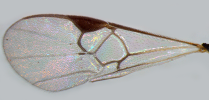 Fig. 2. Fore wing venation Fig. 2. Fore wing venation Fig. 3. Hind leg Fig. 3. Hind leg
ImagesDistributionCosmopolitan.
Hosts / BiologyIt is a solitary larval endoparasitoid of the diamondback moth, Plutella xylostella (L.), a major and cosmopolitan pest of cruciferous vegetables. It is a very common and important biological control agent of P. xylostella.
References
|

